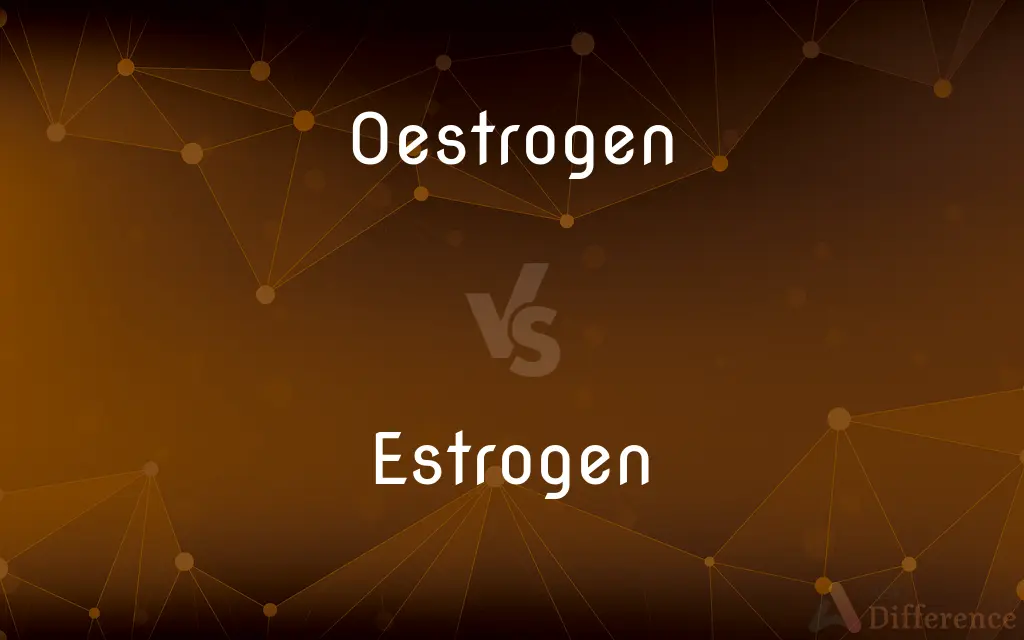Oestrogen vs. Estrogen — What's the Difference?
Oestrogen is the British English spelling for a group of hormone compounds, while estrogen is the American English variant, both referring to the same hormones important in female reproductive health.

Difference Between Oestrogen and Estrogen
Table of Contents
ADVERTISEMENT
Key Differences
Oestrogen is the term used primarily in British English to describe female sex hormones that play a crucial role in regulating the menstrual cycle and reproductive system. These hormones are also involved in other body functions, including bone density and heart health. On the other hand, estrogen is the American English spelling of the same term and refers to the same group of hormones. The difference in spelling reflects the linguistic variations between British and American English.
While oestrogen is commonly used in countries that follow British English conventions, such as the UK, Australia, and New Zealand, estrogen is preferred in the United States and countries that follow American English conventions. This difference in spelling does not indicate any difference in the biological role or chemical composition of the hormones.
Oestrogen and estrogen are involved in various key functions beyond the reproductive system, including maintaining skin health, supporting mood regulation, and influencing body fat distribution. Despite the different spellings, the hormones referred to by both terms perform identical functions in the body.
The spelling variation can sometimes lead to confusion in international communication and scientific writing. However, the context usually makes it clear that both terms refer to the same hormones. In scientific literature, both spellings are accepted, though authors tend to use the spelling that aligns with their local variant of English.
Both oestrogen and estrogen are synthesized in the ovaries, adrenal glands, and fat tissues. They play a critical role not only in the female body but also have functions in the male body, albeit in much smaller amounts. The importance of these hormones transcends the minor differences in spelling, highlighting their universal significance in human health.
ADVERTISEMENT
Comparison Chart
Spelling
Oestrogen
Estrogen
Usage
Predominantly in British English-speaking countries
Predominantly in American English-speaking countries
Biological Role
Regulation of menstrual cycle, reproductive system, and more
Identical to oestrogen
Chemical Composition
Identical to estrogen
Identical to oestrogen
Functions Beyond Reproductive System
Bone density, heart health, mood regulation
Identical to oestrogen
Compare with Definitions
Oestrogen
A group of female sex hormones responsible for the development and regulation of the female reproductive system and secondary sex characteristics.
Oestrogen levels fluctuate throughout the menstrual cycle.
Estrogen
The American English term for hormones that play a critical role in female sexual and reproductive health.
Estrogen levels are important for fertility.
Oestrogen
Involved in various bodily functions beyond reproduction, such as bone health and cardiovascular protection.
Oestrogen plays a key role in maintaining bone density.
Estrogen
Contributes to bone strength, cardiovascular health, and skin maintenance.
Estrogen helps in the prevention of osteoporosis.
Oestrogen
Affects mood and well-being, influencing serotonin levels and other neurotransmitters.
Fluctuations in oestrogen can impact mood and emotional state.
Estrogen
Produced by the ovaries and other tissues, its levels vary with age and health status.
Estrogen production decreases significantly after menopause.
Oestrogen
Produced mainly in the ovaries, and also in smaller amounts by the adrenal glands and fat tissues.
After menopause, oestrogen is still produced but in significantly lower amounts.
Estrogen
Used in medical treatments, such as hormone replacement therapy (HRT).
Estrogen patches are used in HRT to alleviate menopausal symptoms.
Oestrogen
Can be synthesized for use in hormonal therapies and contraceptives.
Oestrogen therapy is often prescribed for menopausal symptoms.
Estrogen
Influences psychological well-being and mood regulation.
Changes in estrogen levels can lead to mood swings.
Oestrogen
Any of a group of steroid hormones which promote the development and maintenance of female characteristics of the body. Such hormones are also produced artificially for use in oral contraceptives or to treat menopausal and menstrual disorders
There is a monthly cycle of oestrogens and progesterone
Estrogen
Any of several steroid hormones, such as estradiol and estrone, that are produced primarily by the ovaries, stimulate the development and maintenance of female secondary sex characteristics, exert systemic effects such as the growth and maturation of long bones, and promote estrus in many female mammals. Estrogens synthesized from plant sources or obtained from horses are used as drugs, primarily to treat estrogen deficiency.
Oestrogen
(British spelling) estrogen
Estrogen
Estrogen or oestrogen, is a category of sex hormone responsible for the development and regulation of the female reproductive system and secondary sex characteristics. There are three major endogenous estrogens that have estrogenic hormonal activity: estrone (E1), estradiol (E2), and estriol (E3).
Oestrogen
Variant of estrogen.
Estrogen
Any of several synthetic compounds that mimic the physiologic activity of estrogen, such as ethinyl estradiol, used primarily in oral contraceptives.
Estrogen
(steroid hormone) Any of a group of steroids that are secreted by the ovaries and function as female sex hormones.
Estrogen
A general term for female steroid sex hormones that are secreted by the ovary and responsible for typical female sexual characteristics
Common Curiosities
Can both men and women produce estrogen?
Yes, both men and women produce estrogen, though women produce it in higher quantities.
What are the main roles of estrogen in the body?
Estrogen regulates the menstrual cycle, supports reproductive health, and plays roles in bone density, cardiovascular health, and mood regulation.
How do estrogen levels change throughout life?
Estrogen levels fluctuate during the menstrual cycle, typically decrease during perimenopause, and are lower after menopause.
How does estrogen affect menopause?
During menopause, the production of estrogen by the ovaries significantly decreases, leading to various symptoms like hot flashes and bone density loss.
What forms of estrogen therapy are available?
Estrogen therapy can come in the form of pills, patches, creams, and vaginal suppositories, among others.
Can estrogen be taken as a supplement?
Yes, estrogen can be prescribed in various forms for hormone therapy, but it should be taken under medical supervision.
Is there a difference in the function of oestrogen and estrogen?
No, oestrogen and estrogen refer to the same hormones and have identical functions in the body.
Why are there two different spellings for estrogen?
The different spellings reflect the linguistic variations between British and American English.
Is estrogen only important for sexual and reproductive health?
No, estrogen also affects bone health, cardiovascular function, skin maintenance, and mood.
Are there any risks associated with estrogen therapy?
Yes, estrogen therapy can have risks, including an increased risk of certain cancers, blood clots, and stroke, depending on the individual's health and the type of therapy.
Share Your Discovery

Previous Comparison
Fender vs. Bumper
Next Comparison
Incentivise vs. Incentivize













































